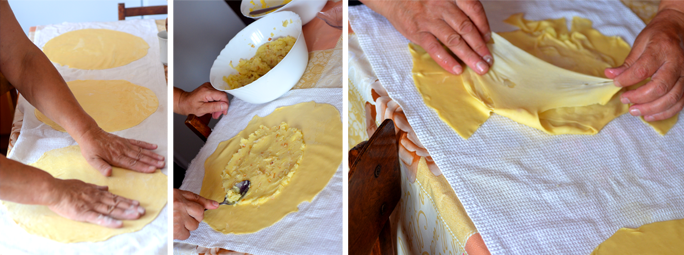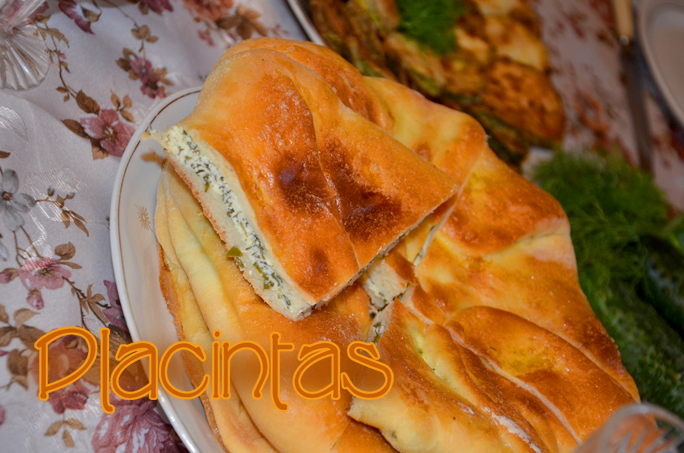Placintas
I may be daring in where I go, but I'm
not that daring in what I eat. However, there wasn't much to fear
on a plate in Eastern Europe. The traditional meal in Tiraspol had
my favorite food – potatoes – so there was no way it could lose.
There was also fried chicken cutlets, home-made cheese, batter fried
zucchini, grape leaves stuffed with rice and mint (topped with sour
cream), Moldavian borscht (also with a couple dollops of sour cream),
and placintas.
Your eyes might have taken a quick double take on the last word in the previous paragraph. It looks very close to a word that has an “e” in it instead of an “i”. And, fortunately, the “c” has a “ch” sound. So, if you pronounce it correctly, it doesn’t sound nearly as gross or messy. Placintas are a pastry brought to the region by the Romans. There are several options for filling which include potatoes, cheese, cabbage, pumpkin, cherries and apples.
Get over the name, pronounce it correctly, and enjoy pla-CHIN-tas!
Ingredients:
Your eyes might have taken a quick double take on the last word in the previous paragraph. It looks very close to a word that has an “e” in it instead of an “i”. And, fortunately, the “c” has a “ch” sound. So, if you pronounce it correctly, it doesn’t sound nearly as gross or messy. Placintas are a pastry brought to the region by the Romans. There are several options for filling which include potatoes, cheese, cabbage, pumpkin, cherries and apples.
Get over the name, pronounce it correctly, and enjoy pla-CHIN-tas!
Mama
Olga's Placinta
Tiraspol, Transistria
Tiraspol, Transistria
| 2 packages of yeast ½ cup milk 1 Tbs sugar 1 tsp salt |
2 cups of butter 7 cups flour 2 eggs filling of choice |
Pastry:
Mix up your yeast with the milk and then stir in the sugar and
salt. Add melted butter, flour, and eggs. Stir them
together.
Buy a rolling pin. Yep, that's right. I don't have one. I've never needed one. I guess I might be able to borrow from a neighbor instead. But, you gotta roll the dough until it is smooth and elastic. Then, roll the dough into balls about the size of a small fist. Let those little dough balls rise for half an hour.
When the rising is done, flour a surface well, and gently roll those dough balls out into flat, thin circles with your newly purchased (or borrowed) rolling pin. Place about a half cup of filling into the center of the dough and then flatten the filling.
Fortunately, I had first-hand experience with this. It's not so hard to spread the filling out on the dough as far as you can spread it. It was a challenge to roll out the dough into a presentable thin circle. Okay, mine wasn’t presentable. But, it was a fun process.
Folding the dough over the filling is an artistic moment. Fold the dough down from the top over the filling. Then, move to the left and fold the dough over filling again. Continue counter-clockwise around the circle. It’s very likely that you may fold the dough eight to ten times as you wrap it over the filling. It will sort of look like a pin-wheel when you are done folding the dough.
Okay, the above method was the artsy-fartsy way I saw at a restaurant. When I made my placintas, it didn't matter which way you fold what as long as the filling was hidden deep inside. There is no pressure here.
Preheat the oven to 400 degrees Fahrenheit and cook the placintas for ten to fifteen minutes.
It is also possible to fry placintas if you need more grease in your life. Heat up the skillet until the oil is sizzling. Then, turn down the heat. Cook the placintas on both sides until they are golden. If the heat is turned down, your dough will cook all the way as it's supposed to. If the heat is too high, you'll have a golden crust and an inner dough. You know you don't want that.

Buy a rolling pin. Yep, that's right. I don't have one. I've never needed one. I guess I might be able to borrow from a neighbor instead. But, you gotta roll the dough until it is smooth and elastic. Then, roll the dough into balls about the size of a small fist. Let those little dough balls rise for half an hour.
When the rising is done, flour a surface well, and gently roll those dough balls out into flat, thin circles with your newly purchased (or borrowed) rolling pin. Place about a half cup of filling into the center of the dough and then flatten the filling.
Fortunately, I had first-hand experience with this. It's not so hard to spread the filling out on the dough as far as you can spread it. It was a challenge to roll out the dough into a presentable thin circle. Okay, mine wasn’t presentable. But, it was a fun process.
Folding the dough over the filling is an artistic moment. Fold the dough down from the top over the filling. Then, move to the left and fold the dough over filling again. Continue counter-clockwise around the circle. It’s very likely that you may fold the dough eight to ten times as you wrap it over the filling. It will sort of look like a pin-wheel when you are done folding the dough.
Okay, the above method was the artsy-fartsy way I saw at a restaurant. When I made my placintas, it didn't matter which way you fold what as long as the filling was hidden deep inside. There is no pressure here.
Preheat the oven to 400 degrees Fahrenheit and cook the placintas for ten to fifteen minutes.
It is also possible to fry placintas if you need more grease in your life. Heat up the skillet until the oil is sizzling. Then, turn down the heat. Cook the placintas on both sides until they are golden. If the heat is turned down, your dough will cook all the way as it's supposed to. If the heat is too high, you'll have a golden crust and an inner dough. You know you don't want that.

Roll your own dough, spread the
filling, and then fold the edges over.
Filling:
Cheese Filling: People in Moldova frequently make their own cheese. It looked like feta cheese to me and feta certainly is the cheese I'm going to use. I'm never going to make my own cheese. The first ingredient is your own cow. You need their fresh milk. Placinta with cheese is usually mixed with fresh dill. The filling can also be made with cottage cheese, an egg or two, and parsley or dill.
Potato Filling: Use one medium potato per placinta pie. Peal the potato and boil until soft. Then, mash the potato and place it in the center of the dough circle. Sprinkle with fried onions if desired. And, it should be.
Cabbage Filling: Fry up cabbage with half an onion until they are soft. Then, they are ready to be placed in the dough.
Cabbage, Potato, and Cheese Placintas are more like main courses. If you make them with cherries, apples, or pumpkin, they are sprinkled with powdered sugar, stuffed with even more sugar, and served as dessert. I, personally, would like to try a pumpkin placinta without the sugar and served as a main course.
Pumpkin Filling: As a dessert, you’d steam chunks of pumpkin and mix in sugar, cinnamon, and nutmeg. Then, top it with icing or powdered sugar. I found it just too sweet. I'd rather try steamed chunks, sautéed onions, and salt & pepper to taste.
Cherry Filling: This filling was my favorite. Hard to imagine, but I liked it more than potato placinta! It was cherry pie to go but a little less messy. Take about three cups of sour (tart) cherries and sprinkle them with sugar. You're good to go. Of course, you want to add even more sprinkled powdered sugar on top with you're done cooking your treat.
Apple Filling: This is the only placinta that I didn't actually eat. Cherry placinta tasted just like you'd expect a cherry filled pastry to taste. I'm sure that apple filling will remind you of apple pie. Okay, core, peel and slice up some apples before you sprinkle in a whole lot of sugar and cinnamon. Just like cherries and pumpkin, you could dust it with powdered sugar when it's all cooked, but I'm going to suggest vanilla ice cream. Of course, if you bought your ice cream in Moldova, it would actually be Italian gelato. So, you can't lose.
Cheese Filling: People in Moldova frequently make their own cheese. It looked like feta cheese to me and feta certainly is the cheese I'm going to use. I'm never going to make my own cheese. The first ingredient is your own cow. You need their fresh milk. Placinta with cheese is usually mixed with fresh dill. The filling can also be made with cottage cheese, an egg or two, and parsley or dill.
Potato Filling: Use one medium potato per placinta pie. Peal the potato and boil until soft. Then, mash the potato and place it in the center of the dough circle. Sprinkle with fried onions if desired. And, it should be.
Cabbage Filling: Fry up cabbage with half an onion until they are soft. Then, they are ready to be placed in the dough.
Cabbage, Potato, and Cheese Placintas are more like main courses. If you make them with cherries, apples, or pumpkin, they are sprinkled with powdered sugar, stuffed with even more sugar, and served as dessert. I, personally, would like to try a pumpkin placinta without the sugar and served as a main course.
Pumpkin Filling: As a dessert, you’d steam chunks of pumpkin and mix in sugar, cinnamon, and nutmeg. Then, top it with icing or powdered sugar. I found it just too sweet. I'd rather try steamed chunks, sautéed onions, and salt & pepper to taste.
Cherry Filling: This filling was my favorite. Hard to imagine, but I liked it more than potato placinta! It was cherry pie to go but a little less messy. Take about three cups of sour (tart) cherries and sprinkle them with sugar. You're good to go. Of course, you want to add even more sprinkled powdered sugar on top with you're done cooking your treat.
Apple Filling: This is the only placinta that I didn't actually eat. Cherry placinta tasted just like you'd expect a cherry filled pastry to taste. I'm sure that apple filling will remind you of apple pie. Okay, core, peel and slice up some apples before you sprinkle in a whole lot of sugar and cinnamon. Just like cherries and pumpkin, you could dust it with powdered sugar when it's all cooked, but I'm going to suggest vanilla ice cream. Of course, if you bought your ice cream in Moldova, it would actually be Italian gelato. So, you can't lose.
